You are currently browsing the publishing category
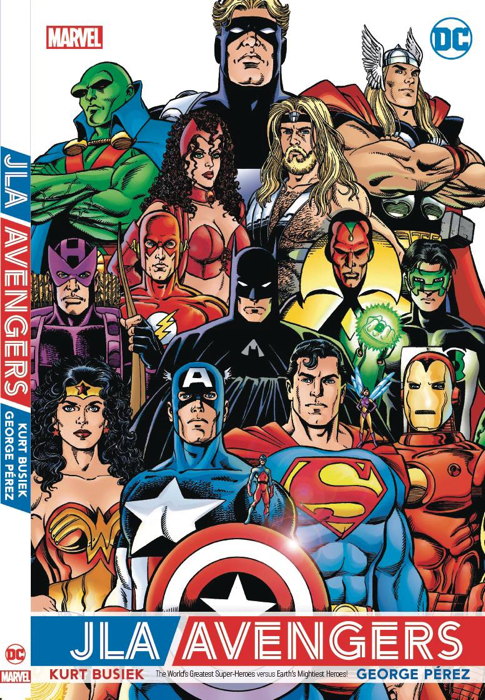
So as I’m sure you’re aware, JLA/Avengers is finally getting a new printing via the comics industry charity Hero Initiative, with all profits going to it. That is, all profits from direct distribution to retailers, but more on that in a second.
What’s putting folks out about this particular minor miracle, which saw Marvel and DC work together for the first time in years in order to allow this republication to happen, is that so few copies, relatively speaking, are going to be available. There’s a printing cap of 7,000 copies, for reasons I’ve seen here and there on the internet ranging from “that’s all we can get printed with the time and resources available” to “lawyers, man, whatcha gonna do?” No idea what the actual answer is, beyond the fact that Hero Initiative probably didn’t sign on to keep the book in print forever, so a max print run had to be set somewhere.
And as you also know, the legendary Mr. Pérez recently announced that he’s stricken with a terminal condition, with only months to live, hence the rush to get this book out while he can still see it. It’s nice that Marvel and DC were able to come to terms to allow a charity reprinting of this series, for which I presume “neither of us are getting the money from this so we’ve got nothing to fight about” helped things along.
But like I said, only 7,000 copies are going to make it out to the world with this printing, minus however many copies get damaged during distribution to retailers. One would hope that DC and Marvel are currently looking at the frenzy this limited availability is causing and are reconsidering any future publishing plans regarding this title. I know there’s some hoohar over profit-sharing on this book, to the point where not publishing it at all and making no money on it is somehow preferable to getting it out there and making at least a little money on it. I’ve said in the past that my solution is just let each publisher release their own trade paperback of JLA/Avengers (or Avengers/JLA for the Marvel book) and keep all profits from their own publication. But I’m sure there are legal/financial reasons from even that being able to happen.
Anyway, all I know is that I’ve been deluged with requests for this book, and I’ve started a first-come/first-served waiting list. For once, the people who actually want the book to read and enjoy were in reasonably early, while the Usual Suspects with the eBay auction listings all ready to go are a day late and a Bitcoin short. But make no mistake, this book is going to be flogged at some sky-high prices the second it’s out. Way to honor George Pérez, guys.
But because there is a limited quantity, and order allocations are almost certain to occur, it is very possible the only person on the list I’ll be able to provide for is the first one who got his name on the list. It is actually very possible, depending on how other stores place their orders, that I get zero copies. If enough bastards out there type “7000” into the order slot on the distributor website to get max allocations, maybe there won’t be enough left over for anyone else.
I’m guessing I’ll get at least the one copy, though. I am ordering a larger number of total copies under the assumption it’s going to be reduced. I was guessing that I’d likely only get about 10% of what I ordered and placed numbers accordingly, but I’m beginning to think 10% is highly optimistic. I also don’t want to order too high, then hear “oh, we’ve upped the print run, everyone’s getting every copy they ordered!” and then I’m stuck with all 7,000 copies. Er, I mean, someone is stuck with that many, I certainly didn’t order 7,000.
Ultimately I hope Marvel and DC do see that people want a nice collected edition of this beautifully-illustrated goofy mess of a comic. The amount of love Pérez put into this comic shouldn’t be forgotten by history or kept out of the hands of fans new to the hobby. I mean, right now the Justice League and the Avengers are at what may very well be their height of cultural awareness (admittedly for drastically different, and not always good, reasons). Strike while that iron (man) is hot.
I am glad it’s back, even for as small a print run as it is, but I’m hoping this leads the way to more copies of it from Marvel and/or DC.
P.S. I always wonder how much negotiation when into things like that cover above. “Superman has to be taller than Captain America.” “Okay, fine, but Cap is standing in front.” “We’ll give you that, but the Atom has to be standing on his shield.”
P.P.S. When reading a few online articles about this, came across one site giving a brief history of Marvel/DC team-ups and saying
“…Doomsday Clock noted a future Marvel and DC crossover called Secret Crisis, but it’s not certain if this is actually in the works.”
NO, IT’S NOT IN THE WORKS, it’s just something Geoff Johns threw in there while making his point about Big Crossover Events. Not saying it can’t happen, especially after Disney buys Warner Bros., but I’m pretty sure it wasn’t intended as an Actual Thing in the Works.
P.P.P.S. Variant cover-age Monday posts are returning, they’re just resting for a moment.
So I was processing a stack of Tick comics acquired from my previous place of employment — stack pictured here:
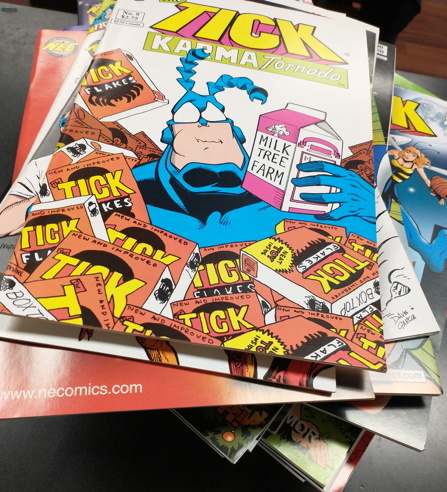
…and boy, there sure were a lot of Tick comics released in the 1999-2002 period. (Of course, the one on top of that stack is from a few years earlier, but I assure you, those are mostly 1999-2001 Tick books.)
I mean, there was Tick: Heroes of the City and Tick Color and Tick and Arthur and Tick & Artie (not to be confused with Tick and Arthur) and The Tick’s Big Cruise Vacation Special and multiple Big Yule Log Specials and The Tick: Circus Maximus and The Tick’s Golden Age Comic and The Tick: The Pseudo Edition (supposedly #13 of creator Ben Edlund’s original Tick series, but not by Edlund) and The Tick’s Incredible Internet Comic and a couple Big Halloween Specials, one of which is inexplicably pricey in the secondary market, and well you get the idea. Perhaps not a patch on the number of Batman books published during the same period, but certainly a lot for a black and white indie title being published during one of the comic industry’s leaner periods.
Now I suppose the popularity of the mid-1990s Tick cartoon spurred the release of all these Tick funnybooks, as well as the then-impending, and then almost immediately cancelled, 2011 live-action TV show. And yes, Tick comics were still relatively popular with readers during this period, so a market definitely existed for all these different publications.
Currently, there are no Tick comics currently being released. Aside from giveaways for Free Comic Book Day and Halloweenfest events, the most recent Tick comic is Tick 2017, released specifically to capitalize on then-new now-defunct Amazon Prime series. I mean, I went back and looked at the original order solicitations, and they specifically cite that TV show, so I’m reasonably sure that was the impetus for this iteration of the comic.
I was a big fan of Ben Edlund’s original 12 issue Tick series. A college buddy of mine had talked about the first issue and it sounded funny, and given I’d just started work at a comic book store, I was in the perfect position to check it out for myself. And I happily stuck with the series through its very erratically-published run.
As it turned out, while I really liked the Tick, I think I only really specifically liked Ben Edlund‘s Tick. I tried other Tick comics, especially after it became obvious Edlund wasn’t going to be producing very many on his own and I wanted more of the character. I sampled many of the spin-offs (I think that Karma Tornado was one of the first) and…they didn’t really do anything for me. They didn’t feel right…like the balance of jokes was off, or the tone wasn’t right, or something.
It’s like reading Plastic Man comics not by Jack Cole, or Peanuts comics not by Charles Schulz, or Howard the Duck stories not written by Steve Gerber. There’s an ineffable quality imparted upon these creations by their creators that other writers/artists can’t really duplicate, and the Tick, at least for me, is no exception. (At least in comic book form, as all the different TV shows are great.)
This is not me being down on all these comics. They have fans, people love ’em, that’s great. They just Weren’t For Me, and not every comic has to be. But I really would like a new, ongoing Tick series of some kind, even if Edlund isn’t around to do it. The Tick is still a popular character people have a lot of affection for, and its absence from the stands is felt. Something new, with a strong creative team, published on a regular basis — that’s what I’d like. Of course, in this weird marketplace we find ourselves in, even building it is no guarantee they’ll come, if I may paraphrase that one movie.
So I’ve been using the DC Universe Infinite digital comics service mostly to try to catch up on many of the comics I picked up but couldn’t read during the earlier and particularly bad months of my eyeball issues, when I wasn’t really able to read anything. I’ve also been using to dip a little farther back into DC’s publishing history, reading some Golden Age books, a lot of the earlier Silver Age Green Lantern (boy, does Hal call Tom that name a lot), and finally reading the entirety of Ostrander’s Suicide Squad run (which I missed during its initial publication). And I keep hoping they’ll add more late ’70s/early ’80s Superman comics to the catalog.
Anther purpose to which I’ve put DC Universe is revisiting some old favorites from my youth, my own copies either buried deep in the remainder of the Vast Mikester Comic Archives, or long since tattered into unreadability and discarded. One of those stories was the “Secret Origin of Red Tornado” two-parter that ran in Justice League of America #192 and #193 in 1981, when I was 12 years old.
I pointed out one short sequence in my last post, where I discussed the occasional brief focus of a team book on developing characters that had no other home on that stands. Now granted pretty much the entire focus of this story was on Red Tornado, but you know what I mean. Getting a little character development in for Reddy’s supporting cast because, you know, where else is that going to happen. (At least not until his own mini-series a few years later.)
Another bit of character development for someone who didn’t have his own title (but was featured in a back-up series in another comic at the time) was this, where the Flash admonishes Firestorm for prematurely (and loudly) giving up on a teammate for dead:
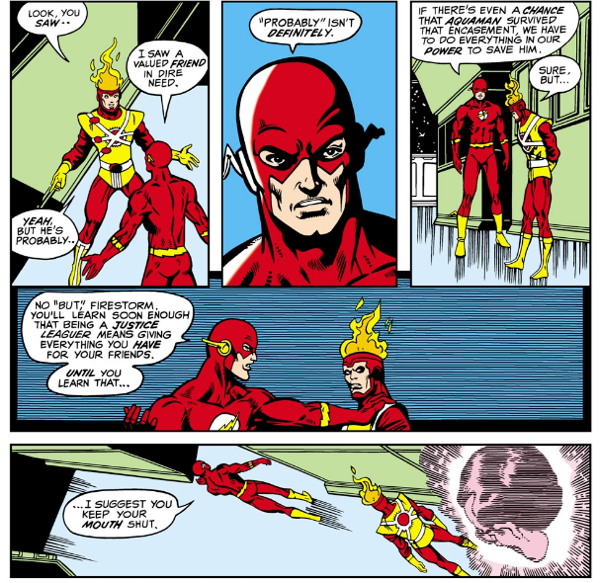
That sequence has stuck with me for a long, long time. Particularly this panel just before it, with Superman giving ol’ Flamehead the super side-eye:
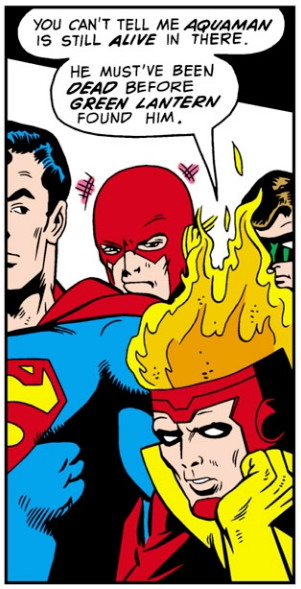
You could just feel that burn of shame on Firestorm’s behalf. And in retrospect, it isn’t necessarily some tossed-away sequence to fill pages and create conflict between members of the team…this was written by Firestorm’s creator, who was also writing those back-ups over in The Flash. As such, it feels like an important part of the character’s development and not just something you could ignore because it didn’t happen in one of his “real” (i.e. solo) stories. I don’t think I appreciated this at the time, but now that I’m older (definitely) and wiser (jury’s still out) I certainly appreciate it now.
Another thing I appreciated about this comic, then and now, is just how much backstory got crammed into this comic. Well, “crammed,” relatively speaking, since this stories did run 52 pages over two issues (at only 50 cents a pop, even) so there felt like there was plenty of space. But there was a good chunk of the narrative given over to expository info needed for the reader to realize the importance of just what’s going on around here.
I mean, we get a retelling of Red Tornado’s beginnings:

We learn about the villain T.O. Morrow, his origin, and what he’s been up to since his last appearances:
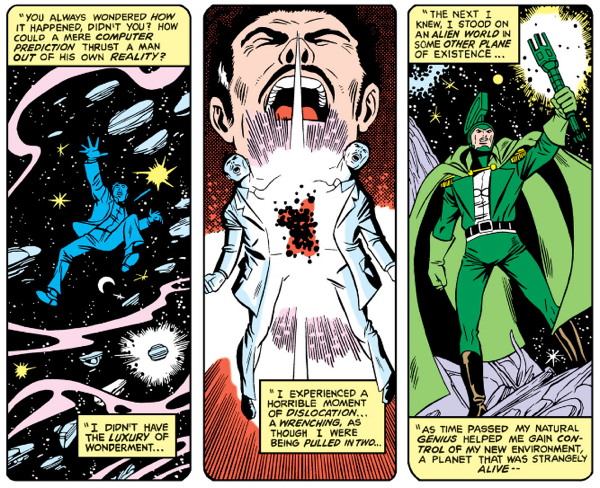
There’s some bonus Adam Strange stuff, tying into the current story:
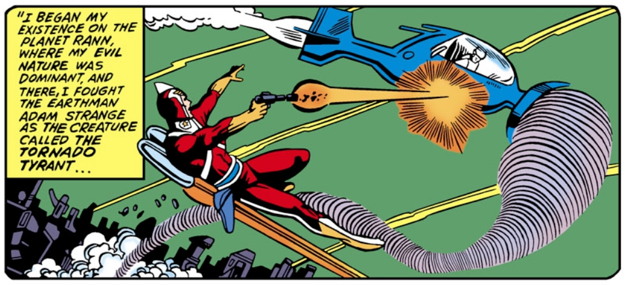
…and that’s not even all of what’s being shown and explained in this book. And it all reads very smoothly. As I said, I was 12 when this came out. I’d been reading comics for a bit, but I didn’t know much about characters like Firestorm and Red Tornado at the time, I certainly didn’t know T.O. Morrow, and while I knew Adam Strange mostly from being featured on the early Nickelodeon program Video Comics, I didn’t really know from the Tornado Tyrant.
It would seem like this is a lot to hit a kid relatively new to comics and some of these characters/concepts, but I do recall finding it absolutely fascinating. Finding out there was a history to these characters, still being referenced, still mattering, that happened long before I entered these worlds, gave the proceedings a depth that they would not have had otherwise. It’s a style of presentation that would shortly have me doing deep dives into Roy Thomas’s DC work, and its reverence for Golden Age tales.
I wasn’t put off…I was attracted by the idea that there was more to learn about all these characters and the worlds they lived in. I know, and I knew even then, that the shared universe at DC (and Marvel too) was built by Many Hands and inconsistencies abounded, but part of the fun was seeing what fit and what didn’t. It’s a feature, not a bug.
I’ve spoken about Crisis on Infinite Eaths before, and how its attempt at codifying and streamlining the DC Universe was compelling reading at the time…perhaps one of the very few times a comic book series had you genuinely concerned for the fate of those involved. It wasn’t until after patch after patch after patch was applied to that firmware upgrade that it began to sink in that the trip Wolfman and Perez took us on was, maybe, not really necessary. Reboots and relaunches began to pile on, and that long history for these characters began to evaporate.
The repeated relaunches of Legion of Super-Heroes threw away all their history in exchange for brief high bursts of first issue sales and slow declines. X-Men, a comic once read by, you know, everyone, splintered into endless spinoffs and relaunches, with no one easily able to follow the thread of stories and characters.
I know there are attempts to redress the shallowness of their fictional worlds. Nearly every crossover event at DC is about trying to make Crisis never-was, with the latest iteration being “every story matters,” however that’s going to work.
This whole post reads like “why aren’t comics like they were when I was a kid,” which comes awfully close to lumping me in with those “comics were never political!” people, and nobody wants that. Comics are always evolving and changing and trying to find their place in a world where they’ve been largely supplanted by, ironically enough, their own enormously popular TV and movie adaptations. There is still lots of good work being done with them, and I still love reading (and selling!) them.
But I do miss the feeling I had of dipping into some comic I hadn’t read before and realizing there’s a whole world here that I’m only barely experiencing in this one issue. Maybe I’ve read comics for too long to have that happen now. Or maybe I’m assuming too much, and that kids do have that same wonder, just not with the same types of comics I read. There’s someone out there whose first volume of Naruto is number 81 and being intrigued by what they’ve discovered, the same way I was 40 years ago, when I decided to pick a comic off the rack that promised secrets to be revealed about Red Tornado.
images from Justice League of America #192-193 (July & Augst 1981) by Gerry Conway, George Perez, and John Beatty
So in answering Alan’s question about what the comic industry might have been like with the success of superhero (read: Marvel) movies, I completely missed the forest for all them cut-down-to-print-Unstoppable Wasp trees. Chris V points out
“I’m pretty sure that if the superhero movie craze was a flop, Disney would have never bought Marvel and Marvel Comics may be on the verge of bankruptcy by 2020, if not already bankrupt before 2020.”
Er, yeah. Marvel was pretty much selling office furniture to keep the lights on in the mid-1990s. There was a very good chance they would have been dead and gone without income from films, and as has been said, “as goes Marvel, so goes the comics industry.” The comics market as we know it might have survived, but almost certainly it would have changed drastically. Well, drastic for people like me working in direct market retail, not so much for all the manga being sold through regular bookstores I’d imagine. At the very least, I wouldn’t have that giant cardboard Groot standup in my store’s front window.
There was also a lot of talk in Wednesday’s comments about what Disney could and should do in regards to helping direct people going to their Avengers movies into stores to find Avengers comics.
There are a couple of things to note about that. First, there’s the thing I said in Wednesday’s post, and that I’ve said plenty of times before: reading serialized comics is pretty much a lifestyle choice. It requires coming to a shop on a regular basis to pick up each new installment. (Or, heaven forfend, if you’re getting them digitally, it requires accessing them on your tablet/phone/whatever and keeping up with them.) That’s not necessarily a habit that comes naturally to people who aren’t already in a comic book reading mindset.
The other issue is another I’ve pointed out from time to time, that for most folks, all the superheroin’ they need is about one movie every few months. They don’t need a regular print diet of of Thor when a Thor movie every few years does ’em fine. They might enjoy paging through a single comic as a novelty, but they’re not going to set up a pull list or anything.
THAT SAID
…there is a non-zero percentage of folks introduced to comics via the movies who do become comic fans. I know. I sell comics to some. We’re not going to get an influx of millions into comic shops because people liked Ant-Man, but we’ll get a few people. And a few is better than none. Maybe some fraction of those will become weekly regular funnybook fans. Maybe some will just pop in to try out a graphic novel or two on occasion (or maybe even once). Or maybe they’ll just become aware there is such a thing as comic book stores, and they’ll know where to go when they need comic-related stuff (for gifts or whatnot).
Disney itself doing anything to directly help comic shops beyond not shuttering Marvel’s publishing division entirely and giving the IP to the merchandising department is, well, unlikely. Like I said in a comment in Wednesday’s post, they’d be more likely to open their own Marvel-exclusive comic stores. And by “more likely” I mean “when pigs fly above a frozen-over Hell.” Any cross promotion between theaters showing superhero movies and comic shops will have to be done on their own. I’m sure some folks have had success giving away comics at theaters, but I’m just imagining that much more stuff for those poor theater employees to clean up off the floors between showings.
A couple things Marvel tried to do to get some of that Marvel movie audience to pay attention to the comics: one was a short X-Men comic in the July 2000 issue of TV Guide:

…and I gotta be honest, I don’t recall that working very well, mostly just being derided a bit. And though I know I read it, I don’t remember anything about the comic itself beyond thinking “this probably isn’t a good introduction to the X-Men.” Ah, well.
The other thing Marvel did was create the “Ultimate” line of books, basically giving fresh starts (and the occasional goatee) to their mainline characters for anyone new to the medium.
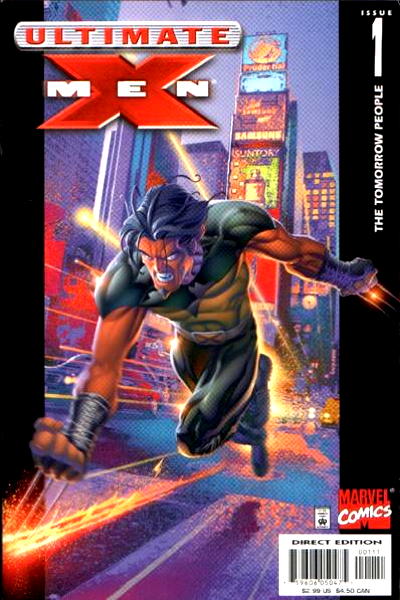
I don’t know how many new-to-comics readers they acquired, or if they just gave already-committed Marvel fans more books to read per month.
This all sounds sorta bitter and negative, and…well, okay, maybe I am being so. But all this isn’t to say outreach via movies and such does no good…just probably not as much good as you think it would.
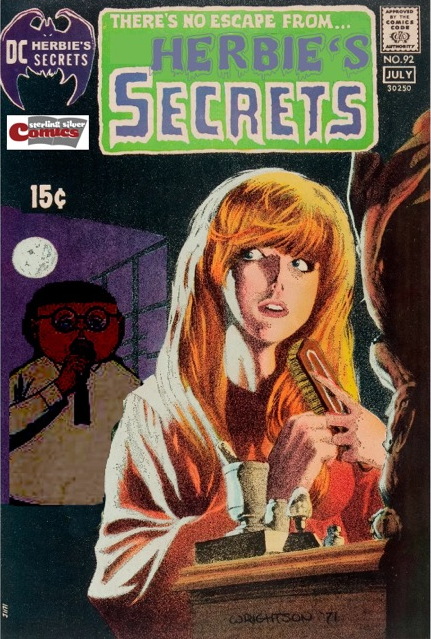
Thanks to reader/mad genius Paul for sending this mock-up of what could’ve been for a Sterling Silver Comics retailer exclusive variant!
Following up on my discussion about that very topic from Monday, I’d actually pulled up an email I received from A Comics Publisher in response to an inquiry I’d made along these lines. Without going into a whole lot of specific detail, let’s just say my buy-in, just for the minimum copy purchase of the exclusive variant, would have been in excess of $10,000. That doesn’t count other minimum orders for the regular cover or other variants of your retailer variant, or for paying for the actual artwork by the artist.
Basically, it’s a lotta scratch…not undoable, entirely, but certainly an investment that would require some first class hustling to make that cash back. Which could be a problem in case you got a cover that didn’t grab the attention of the sort of folks who look for exclusive variants like this. But, to be honest, the way the marketplace is right now, seems like anything that has any form of scarcity is automatically in demand.
Anyhoo, something to think about the next time the opportunity arises.
But speaking of “scarcity,” apparently the latest issue of Usagi Yojimbo, #20, is “in demand” due to it being a first appearance of a character whose name I bet most of the people looking for it couldn’t even tell you. My distributor decided, alas, that this would be one of the comics they’d be shorting from my order last week (there’s usually a few every shipment). I figured that would be that, given it’s temporary hotness and all spare copies eaten up by reorders, I’d have to wait for the second printings to come along so I can get copies for customers who actually want to read it. Somehow, though, miracle of miracles, my replacements showed up! I mean, sure, half my Fireflys are missing and several of my Marvel Voices: Pride shorted or damaged, so it’s always something.
As to the Marvel Voices: Pride comic, it surprised me a bit by including select pages from Alpha Flight #106 (1992). In case you forgot, that’s the comic where Northstar finally just straight up said, after years of subtle-ish hints, “yeah, I’m gay.” Which was, granted, a pretty big deal, and demand for the issue warranted a second printing. But this was also at the height of the whole “gotta be EXTREEEME” art thing, and…yeah, it certainly looks a bit jarring side-by-side with more current art styles. Hey, gotta start somewhere! (Also, did they ever bring back Major Mapleleaf from that story?) (Yes, I know that was a nickname of Alpha Flight’s Guardian at one point.)
I should also note that my comments sections here on Rogressive Pruin occasionally take on a life of their own. So, if you ever wanted to delve deep into the origin of the word/sound/expression “vootie,” well, your day has come.
So y’all had some good suggestions for nice photo covers in the comments for Wednesday’s post, which I appreciate. I especially appreciate Rob Staeger’s reminder that Sandman Mystery Theatre had photo covers for its entire long-ish run, certainly an unusual accomplishment in modern comics. Or this cover noted by BobH with Joe Simon and Jack Kirby.
But here comes customer Sean with a comic I wasn’t aware of…Stan Lee cosplaying as the Black Rider on issue #8 of that title from 1950:
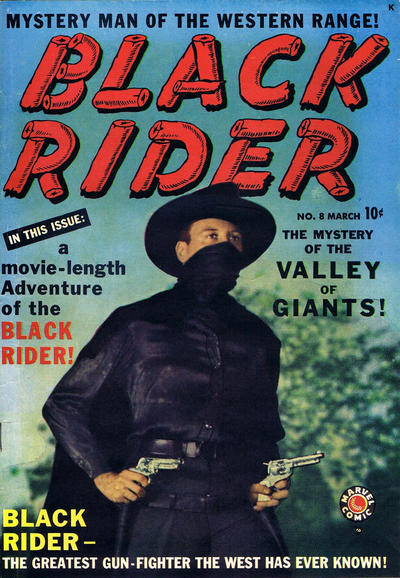
You can Read More About It here on this Stan Lee site.
I mean, just gaze helplessly into the steely stare of Stan the Man, all masked up before it was cool:
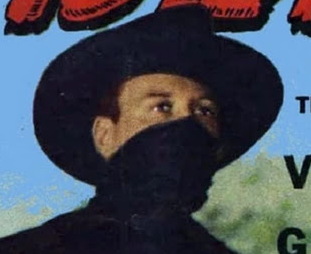
Speaking of ol’ Stan, Eric brings up the Marvel Fumetti Book from 1984 that has him on the cover:
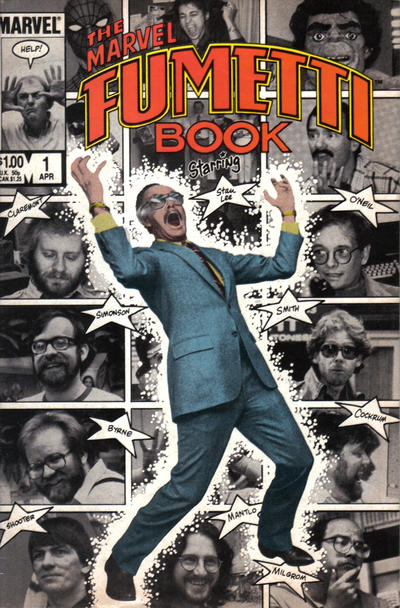
Thanks to the Bullpen Bulletins in every Marvel mag, plus stuff like the in-house news/previews ‘zine Marvel Age, and just the general editorial shenanigans at Marvel since the get-go, the staff and creators at Marvel were more or less known personalities by the readers. Thus, a collection of photo gags starring the folks behind the comics was something they could probably pull off. I wonder if DC could have done something similar at the time? Maybe a bunch of photo-gags starring Wolfman and Perez, or Curt Swan hanging out with Superman (I mean, in “real life,” not in the story in that last panel here), or Alan Moore terrifying the suits around the DC offices…that sort of thing.
Of course prior to that was Fandom Confidential, a photo strip that ran in The Comic Reader and Comic Buyer’s Guide. But perhaps we’re going a little astray from the simple pleasures of just plain ol’ comic book photo covers. Like this one, which isn’t weird at all.
• • •
Also wanted to note the passing of David Anthony Kraft, publisher of the wonderful
Comics Interview magazine, as well as the writer of several swell comics (including, very briefly, some of the original ’70s
Swamp Thing). Mark Evanier has some nice words to say
here. My condolences, of course, to his family, friends, and fans.
So in the comments section for my Gen 13 post, folks started talking about photo covers on comics. I don’t have anything in particular to say about photo covers, though I suppose I could note how of all the too-many variants for Dynamite Entertainment’s Vampirella, Bettie Page, and Red Sonja, it’s the “cosplay” photo covers that move the most for me. (And no, not just for prurient reasons, I promise.)
I can’t think of a whole lot of other photo covers of late, but I have the memory of a goldfish who has pretty bad memory even for a goldfish, so don’t depend on me. I can think of some of Marvel’s movie tie-ins and variants with movie stills.
Oh, wait, I forgot about IDW, which uses photo covers all the time, especially for Doctor Who and Star Trek. Why, way back in 2007 I complained about making the photo cover the ratio variant instead of the regular cover. Why use a drawing of Young William Shatner when you can slap that handsome mug on all your covers and make a mint. Ah well, What Can You Do? In later years a lot of those photo covers from IDW have been freely orderable, some nice, some, um, a little awkward:
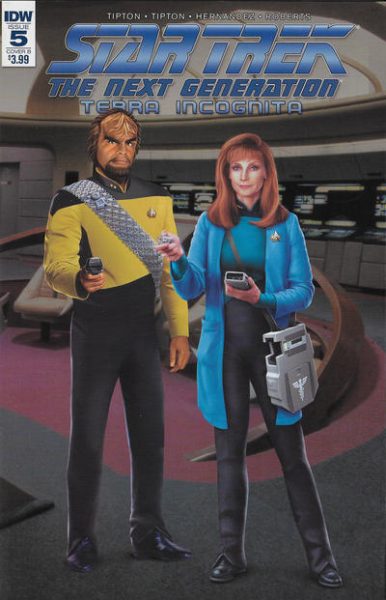
Now there’s no way I’m going to do a comprehensive history of photo covers just off the cuff right this moment…I mean, Turan says this is (maybe) the first superhero photo cover:
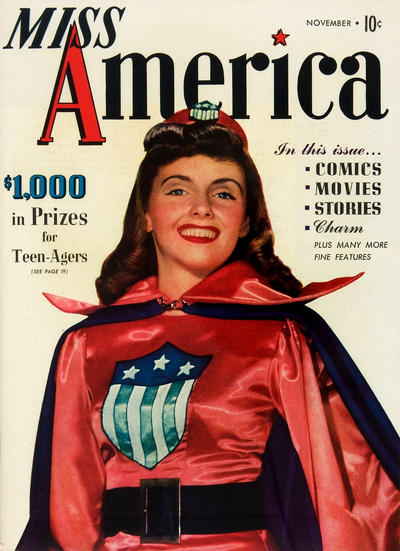
…and sure, I don’t doubt it. Looks like they did a good job on the costume. But I was trying to picture DC doing photo covers from, like, the Batman movie serial and how amazing that would’ve been.
But there were plenty of photo covers to be had in the 1940s and 1950s,especially when celebrities were involved:
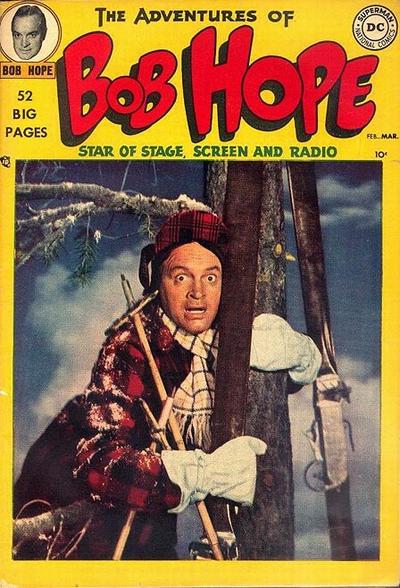
I think my favorites, though, and I don’t see enough of them passing through my store, are the romance comics with photo covers:
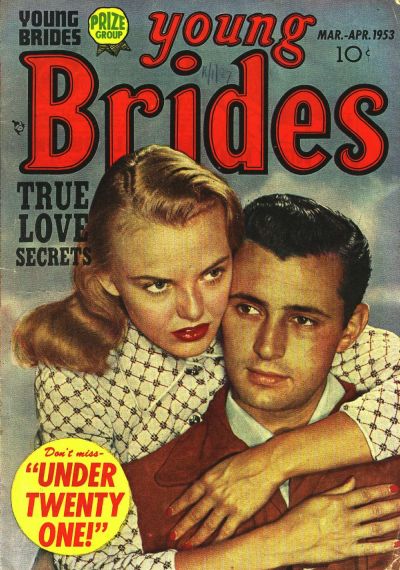
I would love (appropriately enough) to be able to put together a collection of these for myself. Especially Young Brides…there’s Jack Kirby in them there hills, friends!
I’m sure the photo covers (particularly for the romance comics) were there to make the comics look like their slightly more respectable magazine cousins. And the ones with celebrity photos would of course attract fans. Plus there’s the simple matter of photo covers just standing out on the rack…when you’re looking at that beautiful gory layout and see line drawing after line drawing, the sudden appearance of an actual picture of a real human is going to grab your eye. Photo covers were the foil/foldout/hologram gimmick variants of the mid-20th century. Why, if Death’s Head II & The Origin of Die-Cut came out in 1951, I’m sure the cover would featured models in some elaborate costuming!
Anyway, I should note the one cover that seems to come up a lot, one that seems to be fairly common and that even some of you cited at me: 1985’s Amazing Spider-Man #262:
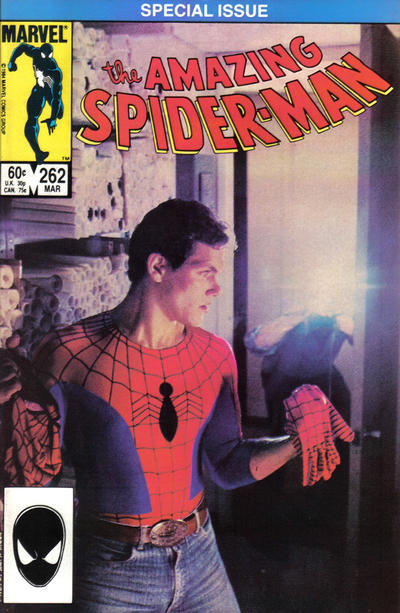
I always thought the cover design was funny, in that it’s got that “SPECIAL ISSUE” blurb across the top, and literally the only thing “special” about this comic was the cover itself. Not slamming the comic or anything (I mean, it’s Bob Layton, it’s fine), but as I recall (and yes, I bought this off the stands at the time because of that cover) it was just a typical Spider-Man story. Not like Aunt May joined with the Venom symbiote, or that Mary Jane pulled off her red wig and revealed she was Gwen Stacy. That cover did its job…it got you to pick up that comic. It sounds like it worked on a lot of you out there as well. Marvel did several photo covers in the ’70s and ’80s (the Dazzler and Spider-Woman are stand-outs, but I have a personal favorite).
Let me wrap this up with possibly the greatest photo cover of all time:
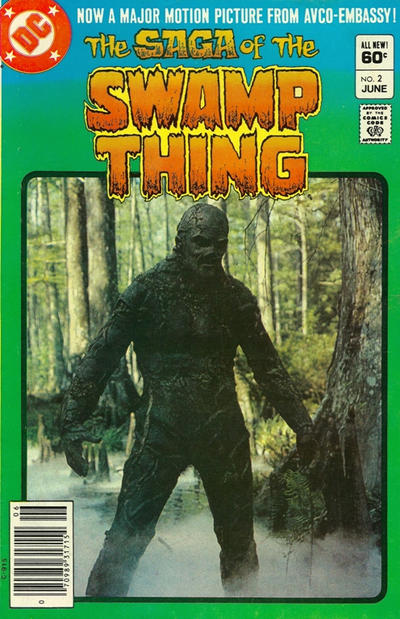
Just your reminder that DC’s Vertigo imprint at least partially owes its existence to Wes Craven and that movie. Far as I’m concerned, that’s a celebrity photo cover for all us Dick Durock fans.
So let me ask you…what are your favorite photo covers?
So you may remember from (cough) nearly a year ago when I was writing a series of posts on intercompany crossovers (as linked here: 1 2 3). My intention was to write one more post on the topic which I never got around to doing, mostly because I feel like I hit bit of a stumbling block. I had in the back of my mind that the fourth post was going to be about the Eclipse Comics series Total Eclipse from 1988 and the First Comics series Crossroads, also from 1988. Must’ve been something in the air that year.
Anyway, when I actually thought about it for a second, I remembered “oh yeah, those aren’t intercompany crossovers, they’re intracompany” featuring characters they alone publish, more in line with, say Marvel Super Heroes Secret Wars or Crisis on Infinite Earths. Why I had these two series linked in my brain with the others, I wasn’t sure at the time. But, y’know, I think I have more of an idea why now. I’ll get to that in a moment.
So let’s talk about this Total Eclipse mini-series:
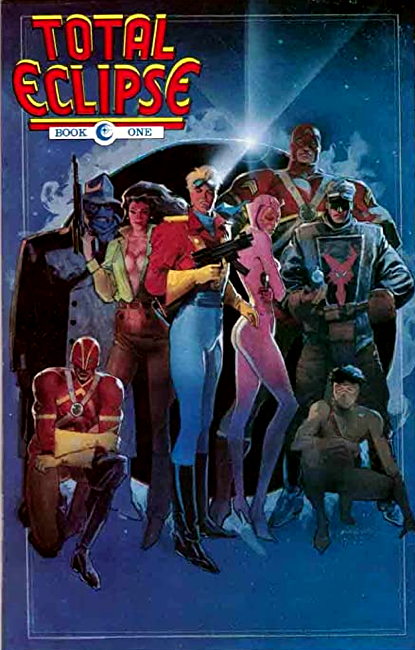
Gotta be honest, haven’t read it in a while, so I have no idea how well it all holds together. I do have a vague sense that, um, it wasn’t the most readable thing in the world, though you had some top talent working on this book. Gorgeous Bill Sienkiewicz covers, Marv Wolfman and Bo Hampton on the main story inside…the book had a solid pedigree.
My personal primary interest in picking up this series was the involvement of Miracleman, whose part in the story eludes me at this late date, even after flipping through my copies pulled from the What’s Left After Putting Everything Else in The Store Mikester Comic Archives. He’s here and there participating in the action and hanging out with the other superhero-type characters and probably giving us a preview for how strange it’s gonna look when Marvel finally starts using the character in the Avengers or whatever.
Of note is a back-up Miracleman story in Total Eclipse #4 by Neil Gaiman and Mark Buckingham, who were the follow-up creators on the main Miracleman title after Alan Moore and John Totleben departed. This was the issue that continued to have back issue sales life long after the series was over, at least while Miracleman was still an ongoing thing and before it vanished into history, never to be seen again except for that brief blip at Marvel a few years back, and whatever the hell it was Todd McFarlane was doing with him in his Spawn comics. It used to have something of a premium price attached to it, though it was hardly in short supply (at least at the time), but that doesn’t seem to be much the case any more. I mean, on eBay someone’s had some luck selling them for $9 a pop, but using the keyword “Gaiman,” no “Miracleman” in sight.
The other major reason I picked up this series was the character Beanish from Tales of the Beanworld, who plays a surprisingly heroic part in the story:
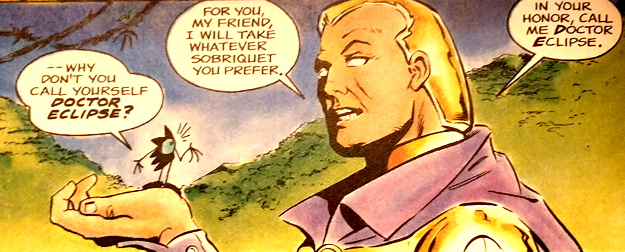
His involvement springs from a direct tie-in in the main Beanworld comic itself, where Beanish, the artist, goes on a near-spiritual journey outside of his home of Beanworld into the greater universe. Beanworld creator Larry Marder (who actually drew Beanish in Total Eclipse) explains the bean’s involvement here. There is a cute moment when Beanish is back in his own comic and he’s trying to explain where he’s been and all he can say is “yeah, it’s pretty complicated,” with a Beanworld-style illustration of a superhero representing his thoughts on everything.
Beanish (or at least, multiples of him) is featured on the cover of Total Eclipse #4 in glorious Sienkiewicz-vision:
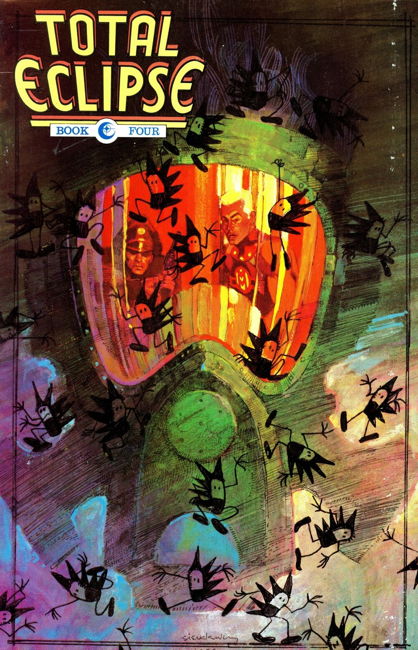
…and even better, he partners up with Miracleman, making them the World’s Finest team…sorry, Bats and Supes!
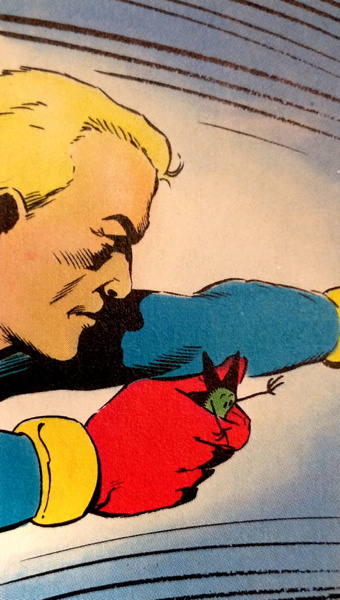
(You can find other outside-their-book appearances of Beanworld characters listed here.)
Kinda paging through the comics here again after so many years, I find that the only things grabbing my attention are the appearances of MM and the Bean (coming this summer to CBS), as I don’t have any particular attachment to most of the other characters. Well, except Destroyer Duck, he’s in here too. Oh, and Mr. Monster shows up. And the Heap. And Ms. Tree. But otherwise…I don’t know, man, I just read it for the characters I liked, which is how these crossover events getcha.
Speaking of which, why did I link this in my mind with intercompany crossovers, which clearly this isn’t? The most obvious reason is that none of these characters were really intended to team up with each other…they were mostly all in their own separate “universes,” for the lack of a better word, with their own genres and storytelling styles and such. They might as well had been published by multiple companies. At least, that’s my story and I’m sticking to it.
The interesting effect of a crossover is the intermingling and, well, “smoothing out” of all the characters involved. In other words, regardless of how they’re portrayed, scriptwise or artwise, in their books, by being pulled together into one story by another creative team they are all essentially unified in look and voice. Curt Swan Superman, Don Heck Wonder Woman, and Rick Hoberg Batman all become George Perez Superman, Wonder Woman and Batman in Crisis. Their disparate characterizations and dialogue all get filtered through one writer’s voice. At Marvel and DC, that’s one thing, where, at least in the superhero universes, everyone’s working in the same milieu.
But with a company like Eclipse, where the point is the variety of creators and genres and styles…cramming it all together into one book, with one artist providing most of the art (I mean, good art by Bo Hampton, with various assistants (with a few presumably working on their own characters like Marder did). The wide variety of art and personality is minimized to a specific vision. Which is fine, but what made some of those characters readable were their creators, and outside that context they can lose a little something.
(I believe the still-unfinished Image United tried to address this issue by having respective creators all do their own characters, but, um, I think there may be a reason why the series is unfinished.)
At least Beanish still shines through in all his weird little bean perfection. Okay, it’s not Marder’s lettering in his word balloons, but I can let that slide.
…So I was going to look at Crossroads from First Comics today, too, but surprise surprise, I went on a bit. I’ll tackle that event next time…promise I won’t take a year to get to it!
So to add to my Superman: Birthright discussion on Monday, the writer of said book, Mark Waid himself, dropped on by to clarify/correct some of my assumptions. Primarily, that Birthright was indeed intended to be the new “official” Superman origin, but was eventually decided that yet another version, the Geoff Johns/Gary Frank Secret Origin mini, would be the new official origin instead. Least ’til, you know, they changed it again.
Anyway, here’s a period article with an interview with Mr. Waid about Birthright being the “official” origin, which was declared so late in the run due to the Super-books being “still somewhat in flux” when the series began. While I was correct in that the state of Superman’s history at that point was a bit mushy and open to revision, as I said in my last post, my assumption that Birthright was a planned out-of-continuity story that eventually ended up in continuity despite itself was incorrect.
So, when you reread that last post of mine, disregard my poor use of Birthright as an example for my thesis. I think my overall entry there is correct, in that if you leave any ambiguity to the canonicity of a story involving DC or Marvel characters in what appears to be their familiar milieus, the default position of a certain subset of fandom regarding that story is that it’s part of official continuity. And that the emphasis, especially by DC, on continually trying to establish what is their official continuity only encourages the behavior.
Not all fans do this, of course, but like I said, I’m still getting customers asking me if Three Jokers is, you know, Real Joker History and, well, what can you do. “It is if you want it to be!” I’ve answered more than once, and I don’t know if that helps, really.
Okay, let me say something about a couple of comics that came out this week:
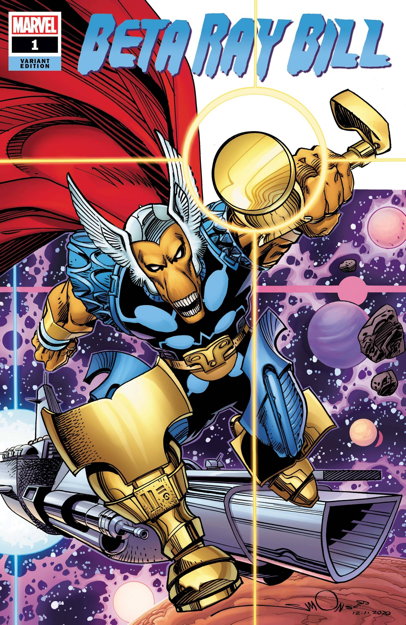
I didn’t keep the cover pictured above…this is one of those “retailer incentive variants” that I have to order a certain number of the regular covers in order to receive. But you think I’m gonna pass up posting a kickass Beta Ray Bill pic by his creator, Walt Simonson, on my site? Heck no.
Anyway, the entirety of my Thor reading is as follows: the Walt Simonson run from #337 to #382 (plus the couple of fill-in issues in that run, which were also great), whatever stories were in the Origins of Marvel Comics books, and the Lee/Kirby “Search for Galactus” issues that pal Cully let me borrow once. Nothing against Thor, and I know some later runs of Thor are very highly regarded, but my brain decided “That’s All The Thor I Need” and that was that, I guess.
When I opened my own shop a few years ago, I gave up my Thors (not Cully’s Thors, I returned ’em, honest) to the back issue bins, which was a good idea because boy did they sell well. As they should, because they’re beautiful and perfect, but “Fanboy Mike” is a tad annoyed at “Retailer Mike” as I kind of miss having those. But hey, I figured at the time I could always pick ’em up in reprints one way or another.
So basically I haven’t been involved in Thor comics for a while. Then why pick up Beta Ray Bill #1? Well, the work of Daniel Warren Johnson for one, who is writing and drawing this book and it looks fantastic. I’m not one for two-page spreads in comics nowaways, but Mr. Johnson throws in a couple of them in this issue and I know I really like a comic when that doesn’t bug me in the slightest. It all feels like a natural extension of Simonson’s rendition of the character without being an imitation of his style, in a way that previous efforts with the Beta Ray Bill have not.
As someone who, as I just told you, hasn’t been immersed in recent Thor comic shenanigans, there wasn’t a steep learning curve for getting caught up to speed on recent Asgardian events. Johnson does a good job naturally slipping in the necessary exposition to establish the world of the book and the premise for the series.
Yes, it is, nominally, a tie-in to the “King in Black” event currently happened at Marvel, but it barely counts, a “Red Skies” type of crossover where a Surprise Guest Monster shows up to wreak havoc in Asgard and oh, he’s all King in BLack-ized or whatever they call it. Could easily just have been Special Surprise Guest Monster all on his lonesome and the effect on the plot wouldn’t have been any different, really. But if it gets more eyeballs on the comic, then we shall let this pious fraud pass.
What I’m saying is that Beta Ray Bill is just as good as I’d hoped it would be, since seeing preview pages a while back. As someone actively not looking to pick up new series right now due to my immense funnybook backlog caused by eyeball issues, I snatched this one up with no regrets.
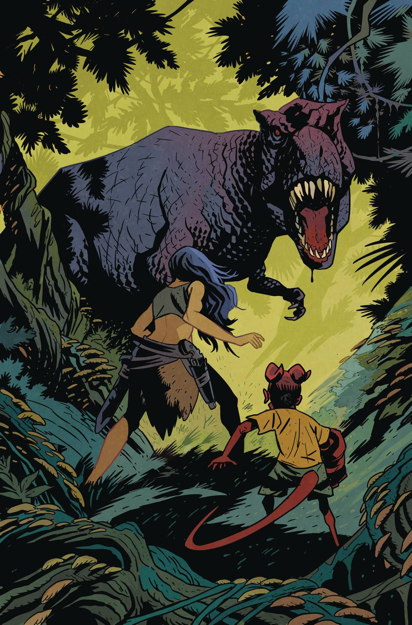
Young Hellboy is a fun, cute series, the second issue of which is out this week. Young Hellboy runs into a Golden Age-style jungle girl on a mysterious island, and seeing HB as an overly talkative, hyperactive child is always entertaining. With the forward motion on the “current” Hellboy timeline effectively ended with, um, the end of the world, it’s nice that we’re still getting “flashback” Hellboy stories. “Hellboy may be dead but his cash flow lives on,” as the Dead Milkmen said (slightly paraphrased). Even knowing the eventual end point for the Hellboy Universe, the sense of impending doom doesn’t weigh too heavily upon these stories…I mean, not that particular doom, anyway.
It’s a nice reminder of what Hellboy was, back before the plot overtook the premise and everything was pointing to The End, versus just the big red guy smacking monsters around and shooting (badly) at demonic foes. Or, as in this series, swinging on a vine and shouting with glee. As I said, fun and cute.
Unlike my hope at the end of the last post addressing Daniel’s comment about DC and the rebooting and the continuities, I do in fact have yet another early morning appointment waiting for me as I write this the night before it. I believe that’s the last of said appointments for a while, the timing of which is unfortunately a necessity when one has a seven-day-a-week job. So let me be quick like the bunny in these responses:
“For me, the DC characters are strongest when they’re in a perpetual state of reboot and/or Elseworlds variations. Seeing a young Batman meet the Joker for the first time in stylistically and narratively different ways each time is infinitely more interesting to me than seeing 80-year-continuity Batman meet the Joker for the 368th time in their ongoing history.”
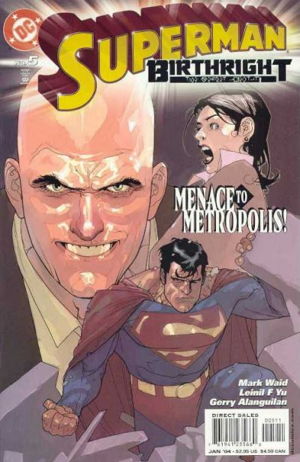 Nearly, urgh, 20 years ago, the mini-series Superman: Birthright by Mark Waid, Leinil Yu and Gerry Alanguilan was released, retelling the early years of Superman’s life. It wasn’t intended to be part of regular continuity; rather, just a fresh interpretation of Superman’s origin by a talented creative team, unburdened by the need to be tied to anything else DC was doing with the character.
Nearly, urgh, 20 years ago, the mini-series Superman: Birthright by Mark Waid, Leinil Yu and Gerry Alanguilan was released, retelling the early years of Superman’s life. It wasn’t intended to be part of regular continuity; rather, just a fresh interpretation of Superman’s origin by a talented creative team, unburdened by the need to be tied to anything else DC was doing with the character.
I suppose what happened was that the story told in Birthright wasn’t distinct enough from mainline continuity…not branded “Elseworlds” or whatever. Not the fault of the creative team, of course, but the Superman story post-Crisis and post-Zero Hour had perhaps become nebulous enough, and distant enough from the mid-1980s John Byrne reboot, that Birthright somehow came to be considered part of the “official” origin. I believe it was this story that reintroduced the Silver Age-y idea of Lex Luthor living in Smallville when he was young, effectively de-aging the Byrne version (who’d already been de-aged via clone/deal with Neron shenanigans that I’m not going into here) from being decades older than Clark Kent to maybe only being a few years, at most.
EDIT: Please check the comments for some clarification from Mr. Waid his own self.
Daniel, I think ideally, for the purposes of DC’s maintenance of a superhero universe, having the “in-continuity” stories is fine. And your idea of having varied tellings and retellings of stories featuring the characters that don’t have to be shoehorned into that continuity is great. Does Batman: Three Jokers fit into the official, current Batman history? Will it ever be referenced outside of a Three Jokers sequel? Probably not. I know I spent a couple of posts picking at the continuity details of this story, but, really, ultimately, it doesn’t matter. It’s a standalone story you can enjoy (or not enjoy, as the case may be) as in-continuity, if you’d like, or outside of it.
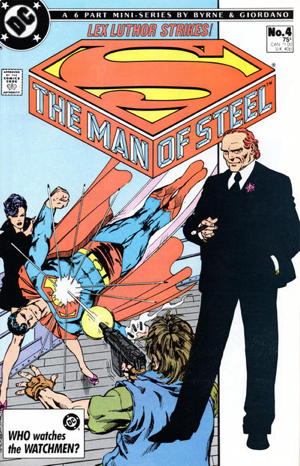 Part of the problem is that DC’s constant obsession with “fixing the universe” in most of their Big Events reemphasizes the idea that Continuity Matters, that all the pieces need to fit and be consistent. So when stuff like Birthright and Three Jokers come along, which (at least in the former, can’t say for sure about the latter) aren’t intended to be part of regular continuity but aren’t immediately identifiable as being separate from it, the readers can get it into their heads that they’re supposed to consider these stories are part of the Official Big Picture. I mean, if Batman’s not, like, a pirate in the story, or Superman’s rocket didn’t land in Norway, which is what DC has essentially trained its readership to look for when considering if a story is, biggest quotation marks ever, “real” or not.
Part of the problem is that DC’s constant obsession with “fixing the universe” in most of their Big Events reemphasizes the idea that Continuity Matters, that all the pieces need to fit and be consistent. So when stuff like Birthright and Three Jokers come along, which (at least in the former, can’t say for sure about the latter) aren’t intended to be part of regular continuity but aren’t immediately identifiable as being separate from it, the readers can get it into their heads that they’re supposed to consider these stories are part of the Official Big Picture. I mean, if Batman’s not, like, a pirate in the story, or Superman’s rocket didn’t land in Norway, which is what DC has essentially trained its readership to look for when considering if a story is, biggest quotation marks ever, “real” or not.
Look, I know most people aren’t worried to this extent about their comic book stories. I read (and am still reading) the Superman comics from the Byrne reboot ’til today, and I can draw a more or less unbroken line from what happened then to what’s going on now. Is everything entirely consistent? No, of course not…it wasn’t even before the whole Flashpoint/New 52/Rebirth hoohar. Does that bother me? Nah, not really. I tend to go on about some of the inconsistencies here on this site, but more out of amusement than outrage. As a wise philosopher once almost said, “it’s just a [comic book], I should really just relax.”
In short, if I can ever be short, DC has its readership used to the idea that continuity is paramount, and therefore every story has to “count.” Thus, doing stories that aren’t necessarily in continuity can become difficult to distinguish as such unless they contain gimmicks that decidedly make them outside the main storylines. Thus, anyone really bothered by this sort of thing, which isn’t everybody, I know, but it ain’t zero people, can find things to be confusing.
“And I think that this is part of DC’s brand management problem. I believe that there are just as many people like me who love the excitement and variation of reboots as there are people who prefer (and want to perpetuate) the never-ending 80-year soap opera. And any attempt to go in one direction or the other will inevitably alienate the other audience.”
I know DC has been messing with branding logos on their comics to identify which “family” their books are in, with a general “DC Universe” for those without specific categories. Maybe a general icon that means “YES, THIS IS IN WHATEVER OUR CONTINUITY IS NOW.” Which is its own problem, because then maybe people wouldn’t buy the one-offs and minis without the logo because they’re outside continuity? You see the difficulty. I think just ending the Big Event reboots, and changing things as necessary in the comics as time goes on, without making a big deal out of it, is the best solution. If DC stops making such a big deal out of continuity, maybe readers will too. Well, some readers, anyway. I’ve been at this too long, I know better.
I don’t know. I think folks should just read the stories they like and if they want to think some story is or is not part of the larger picture, then go to town, friend. In my personal head canon, those stories where Alec Holland’s brother “cures” Alec, followed by Swamp Thing teaming up with the Challengers of the Unknown and Deadman are all still part of the character’s history, and nobody’s gonna tell me different.
« Older Entries
Newer Entries »

























 Nearly, urgh, 20 years ago, the mini-series Superman: Birthright by Mark Waid, Leinil Yu and Gerry Alanguilan was released, retelling the early years of Superman’s life. It wasn’t intended to be part of regular continuity; rather, just a fresh interpretation of Superman’s origin by a talented creative team, unburdened by the need to be tied to anything else DC was doing with the character.
Nearly, urgh, 20 years ago, the mini-series Superman: Birthright by Mark Waid, Leinil Yu and Gerry Alanguilan was released, retelling the early years of Superman’s life. It wasn’t intended to be part of regular continuity; rather, just a fresh interpretation of Superman’s origin by a talented creative team, unburdened by the need to be tied to anything else DC was doing with the character.  Part of the problem is that DC’s constant obsession with “fixing the universe” in most of their Big Events reemphasizes the idea that Continuity Matters, that all the pieces need to fit and be consistent. So when stuff like Birthright and Three Jokers come along, which (at least in the former, can’t say for sure about the latter) aren’t intended to be part of regular continuity but aren’t immediately identifiable as being separate from it, the readers can get it into their heads that they’re supposed to consider these stories are part of the Official Big Picture. I mean, if Batman’s not, like, a pirate in the story, or Superman’s rocket didn’t land in Norway, which is what DC has essentially trained its readership to look for when considering if a story is, biggest quotation marks ever, “real” or not.
Part of the problem is that DC’s constant obsession with “fixing the universe” in most of their Big Events reemphasizes the idea that Continuity Matters, that all the pieces need to fit and be consistent. So when stuff like Birthright and Three Jokers come along, which (at least in the former, can’t say for sure about the latter) aren’t intended to be part of regular continuity but aren’t immediately identifiable as being separate from it, the readers can get it into their heads that they’re supposed to consider these stories are part of the Official Big Picture. I mean, if Batman’s not, like, a pirate in the story, or Superman’s rocket didn’t land in Norway, which is what DC has essentially trained its readership to look for when considering if a story is, biggest quotation marks ever, “real” or not. 





